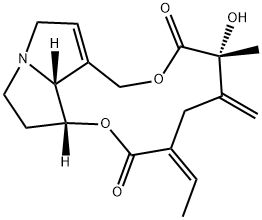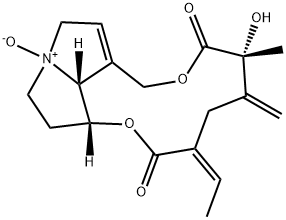Seneciphylline , 98% , 480-81-9
Synonym(s):
α-Longilobin;3,19-Didehydro-12-hydroxysenecionan-11,16-dione;Jacodine
| Pack Size | Price | Stock | Quantity |
| 5mg | RMB2128.00 | In Stock |
|
| others | Enquire |
PRODUCT Properties
| Melting point: | 217°C |
| alpha | D -128° (chloroform) |
| Boiling point: | 470.34°C (rough estimate) |
| Density | 1.2467 (rough estimate) |
| refractive index | 1.5740 (estimate) |
| storage temp. | -20°C |
| solubility | DMF: 5 mg/ml; DMSO: 2 mg/ml; Ethanol: 1 mg/ml; PBS (pH 7.2): 0.1 mg/ml |
| pka | 12.43±0.20(Predicted) |
| form | Solid |
| color | White to off-white |
| Stability: | Stable, but reacts with oxygen in the air. Incompatible with alkali, oxidizing agents. Store under inert gas. |
| LogP | 0.810 (est) |
| CAS DataBase Reference | 480-81-9 |
| IARC | 3 (Vol. 10, Sup 7) 1987 |
| EPA Substance Registry System | Seneciphylline (480-81-9) |
Description and Uses
Seneciphylline, a pyrrolizidine alkaloid, one of the main components of Chinese medicine herb Tusanqi, which is a reason of the hepatic sinusoidal obstruction syndrome (HSOS). In addition, experiments on rats have shown that seneciphylline had adverse effects on the development and organic morphodifferentiation of embryos, thus the pregnant people exposed to Hebra may get potential risk on the fetus.
Seneciphylline is a minor constituent of S. jacobaea, which has been used as a medicinal herb in Europe. It has the effect of coagulation and hemostasis.
Seneciphylline is a pyrrolizidine alkaloid with the potential to affect hepatic drug metabolizing enzymes in rat cells.
Safety
| Symbol(GHS) |  GHS06 |
| Signal word | Danger |
| Hazard statements | H300+H310+H330 |
| Precautionary statements | P260-P262-P280-P301+P310+P330-P302+P352+P310-P304+P340+P310 |
| Hazard Codes | T |
| Risk Statements | 23/24/25-25 |
| Safety Statements | 1-20-24/25-45 |
| RIDADR | 1544 |
| WGK Germany | 3 |
| HazardClass | 6.1(b) |
| PackingGroup | III |
| Hazardous Substances Data | 480-81-9(Hazardous Substances Data) |





